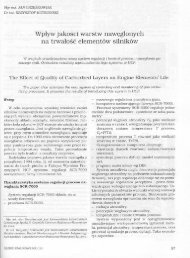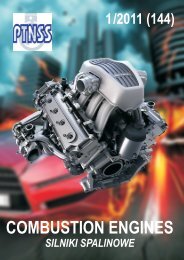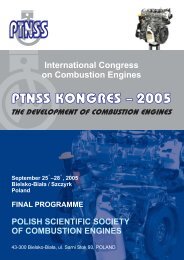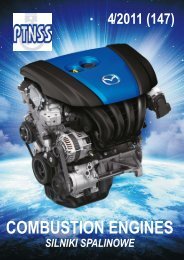Create successful ePaper yourself
Turn your PDF publications into a flip-book with our unique Google optimized e-Paper software.
The use of multi-equation models in the analysis of dynamic processes...<br />
The issue of selecting the best model out of a class of<br />
equations (11) in the sense of minimizing the quality coefficient<br />
of identification was solved using the orthogonal<br />
projection theorem [3, 6]. Given the vastness of the issue,<br />
the shift leading to the equation in the matrix form was<br />
omitted:<br />
where:<br />
(12)<br />
[obr/min]; x 2<br />
– moment obrotowy silnika T tq<br />
[N·m]; x 3<br />
– zakoksowanie<br />
dysz rozpylacza S k<br />
[µm 2 ]. Podobnie postąpiono<br />
ze zbiorem wielkości wyjściowych Y, ograniczając liczbę<br />
jego elementów tylko do podstawowych związków toksycznych<br />
w kolektorze wylotowym: y 1<br />
– stężenie tlenku węgla w<br />
kolektorze wylotowym spalin C CO(k)<br />
[ppm]; y 2<br />
– stężenie węglowodorów<br />
w kolektorze wylotowym spalin C HC(k)<br />
[ppm];<br />
y 3<br />
– stężenie tlenków azotu w kolektorze wylotowym spalin<br />
C NOx(k)<br />
[ppm]. Zmiany wielkości wejściowych i wyjściowych<br />
podczas procesu dynamicznego przedstawiono na rys. 1.<br />
Identyfikacji statystycznej dokonano za pomocą programu<br />
GRETL [2]. Estymację współczynników równań<br />
poszczególnych zmiennych wyjściowych przeprowadzono<br />
za pomocą metody najmniejszych kwadratów, a miała ona<br />
na celu weryfikację istotności jej parametrów i w efekcie<br />
odrzucenie wartości nieistotnych, co w konsekwencji doprowadziło<br />
do znacznego uproszczenia modeli. Wartości<br />
x1 = f(t)<br />
x2 = f(t)<br />
Thus, the matrix equation (12) can be expressed as:<br />
Which gives<br />
(13)<br />
(14)<br />
Thus, the optimal coefficients i = 1, 2,..., m, m+1,...,<br />
m+n of the reduced model form (10) can be determined<br />
from the equation:<br />
x3 = f(t)<br />
y1 = f(t)<br />
<strong>COMBUSTION</strong> <strong>ENGINES</strong>, No. 4/2012 (151)<br />
(15)<br />
– matrix of measured values of signals y 1<br />
, y 2<br />
,...,<br />
y n<br />
, x 1<br />
, x 2<br />
,..., x m<br />
,<br />
– matrix transposed to the matrix of measured<br />
values of input signals,<br />
y 1<br />
, y 2<br />
,..., y m<br />
,<br />
– inverse to the Gram matrix<br />
– matrix of measured values of output signals<br />
– matrix transposed to the matrix of measured<br />
values of output signals,<br />
y 2<br />
= f(t)<br />
y 3<br />
= f(t)<br />
Fig. 1. Changes of the input and output quantities during the dynamic<br />
process where: x 1<br />
– engine speed n [rpm]; x 2<br />
– engine torque T tq<br />
[N·m];<br />
x 3<br />
– coking of the spray nozzle S k<br />
[µm 2 ]; y 1<br />
– concentration of carbon<br />
monoxide in the exhaust manifold C CO(k)<br />
[ppm]; y 2<br />
– concentration of<br />
hydrocarbons in the exhaust manifold C HC(k)<br />
[ppm]; y 3<br />
– concentration<br />
of nitric oxides in the exhaust manifold C NOx(k)<br />
[ppm]; t – duration of the<br />
process [s]<br />
Rys. 1. Zmiany wielkości wejściowych i wyjściowych podczas procesu<br />
dynamicznego: x 1<br />
– prędkość obrotowa silnika n [obr/min]; x 2<br />
– moment<br />
obrotowy silnika T tq<br />
[N·m]; x 3<br />
– zakoksowanie dysz rozpylacza S k<br />
[µm 2<br />
]; y 1<br />
– stężenie tlenku węgla w kolektorze wylotowym spalin C CO(k)<br />
[ppm]; y 2<br />
– stężenie węglowodorów w kolektorze wylotowym spalin<br />
C HC(k)<br />
[ppm]; y 3<br />
– stężenie tlenków azotu w kolektorze wylotowym spalin<br />
C NOx(k)<br />
[ppm]; t – czas trwania procesu [s]<br />
83












